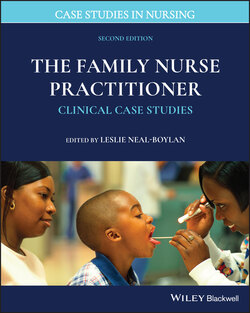Читать книгу The Family Nurse Practitioner - Группа авторов - Страница 14
ОглавлениеCase 1.1 Cardiovascular Screening Exam
By Mikki Meadows‐Oliver, PhD, RN, FAAN
SUBJECTIVE
Justin, a 10‐day‐old male, presents in the primary care office for a weight check. He is accompanied by his parents. His mother is concerned about his feeding habits. She believes that he takes awhile to drink his formula—longer than his siblings did; she also thinks that he sweats more than they did, even when he doesn’t feel warm.
Birth history: Significant for a 36‐week gestation. His birth weight was 2600 grams. Because of his premature birth, Justin required hospitalization for the first week of life in the Neonatal Intensive Care Unit (NICU). During his stay in the NICU, he was noted to feed without problems, maintain his temperature without assistance, and gain weight. His weight at discharge from the hospital 3 days ago was 2400 grams. Because of his premature birth status and his decreased weight, the family was told to follow up with their primary care provider in 3 days.
In the office today, his weight is 2490 grams. Further questioning about Justin’s birth history reveals that the mother’s pregnancy was normal. She had no infections, falls, or known exposures to environmental hazards. She did not drink alcohol, take prescription medication (other than prenatal vitamins), use tobacco products, or use illicit drugs. During labor, she experienced a failure to progress, which resulted in her having a cesarean birth. The baby’s Apgar scores were 8 at 1 minute and 9 at 5 minutes.
Social history: Justin was born to a single, 29‐year‐old mother. His father is involved but does not reside in the household. Justin lives in an apartment with his mother and two other siblings (ages 2 and 4 years). The maternal grandmother (MGM) lives nearby and is able to help Justin’s mother provide care. The family receives several governmental subsidies such as the Women, Infants, and Children (WIC) Supplemental Nutrition Program, Temporary Assistance for Needy Families (TANF), and Medicaid. Educationally, Justin’s mother has a high school diploma. She works in a local retail store. Justin’s father works in a manufacturing plant. The family has no pets. The MGM smokes but does not smoke in the home.
Diet: Breastfeeding ad lib with supplementation of a milk‐based formula.
Elimination: 6–8 wet diapers daily with 3–4 yellow, seedy bowel movements.
Sleep: Sleeps between feedings.
Family medical history: PGF (age 54): diabetes mellitus, heart attack at age 50; PGM (age 53): healthy; MGF: deceased from stroke at age 47; MGM (age 54): asthma; mother (age 29): asthma; father (age 31): healthy; Sibling #1 (age 4): asthma; Sibling #2 (age 2): heart murmur.
Medications: Currently taking no prescription, herbal, or OTC medications.
Allergies: No known allergies to food, medications, or environment.
OBJECTIVE
Vital signs: Weight: 2490 grams; length: 44 centimeters; temperature: 37°C (rectal).
General: Alert, well‐nourished, well‐hydrated baby.
Skin: Clear with no lesions noted; no cyanosis of lips, nails, or skin; no diaphoresis noted; skin turgor with elastic recoil.
Head: Normocephalic; anterior fontanel open and flat (2 cm × 3 cm); posterior fontanel open and flat (1 cm × 1 cm).
Eyes: Red reflex present bilaterally; pupils equal, round, and reactive to light; no discharge noted.
Ears: Pinnae normal; tympanic membranes gray bilaterally with positive light reflex.
Nose: Both nostrils patent; no discharge.
Oropharynx: Mucous membranes moist; no teeth present; no lesions.
Neck: Supple; no nodes.
Respiratory: RR = 28; clear in all lobes; no adventitious sounds noted; no retractions; no deformities of the thoracic cage noted.
Cardiac/Peripheral vascular: HR = 120; thrill noted in pulmonic area; continuous, systolic, grade 3 heart murmur noted on exam in the pulmonic area of the chest with both the bell and diaphragm; no radiation of the murmur to the back or axilla; brachial and femoral pulses present and 2+ bilaterally.
Abdomen/Gastrointestinal: Soft, nontender, nondistended, no evidence of hepatosplenomegaly. Umbilical cord is in place with no signs and symptoms of infection.
Genitourinary: Normal male; testes descended bilaterally; circumcision healing well.
Back: Spine straight.
Extremities: Full range of motion of all extremities; warm and well perfused; capillary refill <2 seconds. Negative hip click.
Neurologic: Good suck and cry; good tone in all extremities; positive Moro, rooting, plantar, palmar, and Babinski reflexes.
CRITICAL THINKING
1 Which diagnostic or imaging studies should be considered to assist with or confirm the diagnosis?___Chest X‐ray (CXR)___Echocardiogram___Electrocardiogram
2 What is the most likely differential diagnosis and why?___Patent ductus arteriosus___Venous hum___Atrioventricular malformation
3 What is the plan of treatment, and what should be the plan for follow‐up care?
4 Are there any referrals needed?
5 Does this patient’s psychosocial history influence how you might treat her?
6 What if this baby were a girl?
7 What if this baby had been born full term?
8 What if this baby had been born at a higher altitude?
9 Are there any standardized guidelines that should be used to assess or treat this case?
